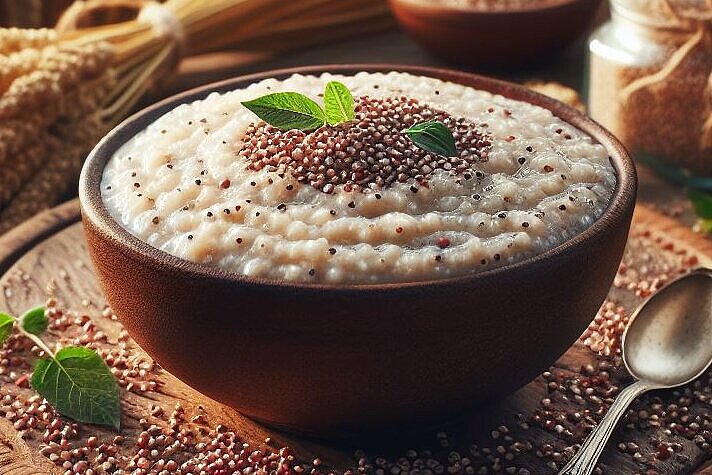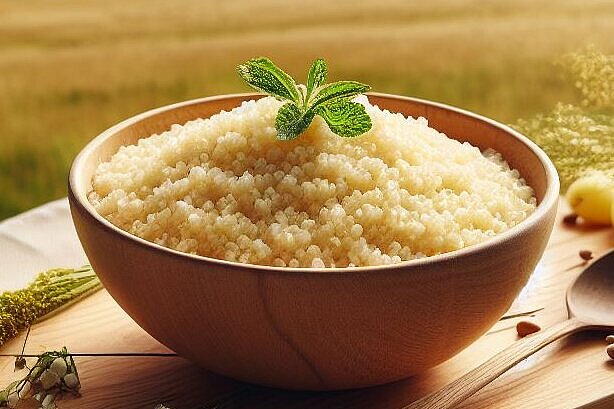Millet porridge

What is millet porridge for dogs?
Millet porridge for dogs is a supplementary food consisting of cooked or swollen millet grains. Millet is a husk cereal that is one of the oldest cultivated plants in the world. There are different types of millet, such as golden millet, brown millet or foxtail millet. Golden millet and brown millet are particularly suitable for feeding dogs as they have a high nutrient content.
Millet porridge for dogs can be served as a side dish with meat or vegetables or as the main component of a vegetarian or vegan menu. Millet porridge for dogs should always be freshly prepared and kept in the fridge for no longer than one day.
How do I prepare millet porridge for dogs?
You only need a few ingredients to prepare millet porridge for dogs:
- Millet grains or millet flakes
- water
- Optional: a little oil or butter
If you are using whole millet grains, you should wash and drain them thoroughly before cooking. Then put the millet in a pan with double the amount of water and a little salt. You can also add a little oil or butter to improve the flavor and promote nutrient absorption. Then bring the water to the boil and leave the millet to soak on a low heat for around 20 minutes until it is soft.
If you are using millet flakes, you only need to soak them in hot water until they are swollen. This takes about 10 to 15 minutes.
You can feed the finished millet porridge for dogs on its own or mix it with other ingredients, such as
- Meat (e.g. beef, lamb, turkey)
- Vegetables (e.g. carrots, zucchinis, pumpkin)
- Fruit (e.g. apple, pear, banana)
- Herbs (e.g. parsley, thyme, rosemary)
Make sure that you always chop or puree the ingredients well so that your dog can digest them better.
What are the benefits of millet porridge for dogs?
Millet porridge for dogs has many benefits for the health and well-being of your four-legged friend. Here are some of them:
- Millet is rich in protein, which is important for muscle building and cell regeneration.
- Millet contains a lot of iron, which is essential for blood formation and oxygen supply.
- Millet provides a lot of fiber, which stimulates digestion and supports the intestinal flora.
- Millet is gluten-free and therefore also suitable for dogs with a gluten intolerance or food allergy.
- Millet has a high antioxidant content, which protects the body's cells from free radicals and strengthens the immune system.
- Millet contains many minerals such as magnesium, zinc and potassium, which are important for nerve, muscle and bone function.
- Millet provides dogs with unsaturated fatty acids, which nourish the skin and coat and reduce inflammation.
What are the disadvantages of millet porridge for dogs?
Millet porridge for dogs also has some disadvantages that you should be aware of. Here are some of them:
- Millet is a source of carbohydrates, which causes blood sugar levels to rise. This can be problematic for dogs with diabetes or who are overweight.
- Millet can cause bloating or diarrhea in some dogs, especially if fed too quickly or too much.
- Millet can contain traces of heavy metals such as cadmium or lead, which can accumulate in the body. This can lead to health problems if the millet does not come from controlled cultivation.
- Millet alone is not a complete dog food, but must always be supplemented with other sources of nutrients to ensure a balanced diet.
Millet porridge for dogs is a complementary food that has many benefits for your dog's health and well-being. It is gluten-free, easily digestible and rich in protein, iron, fiber and antioxidants. You can easily prepare it yourself and combine it with other ingredients to offer your dog a varied and tasty menu.
However, you should also be aware of the disadvantages of millet porridge for dogs and not use it as a complete food. Make sure that you feed the millet in moderation and pay attention to the quality.
If you notice any signs of hypersensitivity or poisoning in your dog, you should see your vet immediately. We are not a substitute for a vet, but we try to be as accurate as possible. Every dog reacts differently and we recommend you get a second opinion or consult your vet if in doubt.
Stay healthy and take good care of your four-legged friend!😊
Similar to Millet porridge
Amaranth porridge is a warm dish made from cooked amaranth grains. It has a creamy consistency and a nutty taste. You can refine it with various ingredients, such as fruit, nuts or honey. Amaranth...
Semolina porridge is a porridge made from milk and wheat semolina, sweetened with sugar. Sometimes cinnamon or vanilla is added to enhance the taste. Semolina porridge can be eaten warm or cold and...
Porridge is a porridge made from cooked oat flakes and water. Oatmeal is made from the grain oats and contains many valuable nutrients, such as Fiber, which aids digestion and supports the...
A culinary basis Milk porridge is a simple dish made from milk and cereals (such as oats, wheat or rice), where the mixture is cooked to a porridge-like consistency. It is often refined with sugar...



